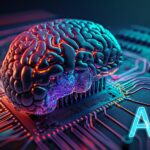Artificial Intelligence (AI) is no longer a futuristic concept limited to the realms of science fiction. It is a rapidly evolving technology that is reshaping how industries function and has the potential to solve some of the world’s most pressing challenges. From healthcare to climate change, AI’s ability to analyze vast amounts of data and make decisions at lightning speed can drive solutions to global problems. In this article, we’ll explore how AI can be leveraged to tackle some of the most critical issues humanity faces today and the potential it holds for creating a more sustainable and equitable future.
1. AI in Healthcare: Improving Global Health Outcomes
1.1 Revolutionizing Diagnostics and Treatment
AI has shown tremendous potential in revolutionizing healthcare by enabling faster, more accurate diagnostics. Traditional diagnostic methods often require a combination of medical knowledge and human intuition, but AI systems are capable of analyzing large datasets, including medical imaging, genetic data, and patient records, to identify patterns and anomalies that might be missed by human doctors.
- AI-powered imaging tools can identify diseases such as cancer, diabetes, and heart disease earlier than conventional methods. For example, AI systems trained on vast amounts of radiology data can detect early-stage cancers in medical images with accuracy comparable to, or even exceeding, that of trained radiologists.
- Personalized treatment plans are becoming more common thanks to AI. By analyzing patient data, AI systems can recommend the most effective treatments tailored to an individual’s genetic makeup and medical history.
1.2 AI in Disease Prevention and Control
AI can also play a pivotal role in disease prevention by predicting outbreaks and identifying at-risk populations. For instance, AI-based models can analyze environmental data, social trends, and historical records to predict the spread of infectious diseases such as malaria, Ebola, and COVID-19. This allows for earlier intervention and more efficient resource allocation to curb the spread of these diseases.
- AI-powered wearable devices can also track vital health metrics in real-time, providing data to both patients and healthcare providers. This is especially useful in managing chronic conditions such as diabetes and hypertension, reducing the need for frequent hospital visits.
2. AI in Climate Change and Environmental Conservation
2.1 Tackling Climate Change
Climate change is one of the most significant global challenges we face, and AI is poised to be an essential tool in mitigating its effects. AI can analyze complex environmental data and simulate various climate models to predict future climate patterns, identify areas at risk, and suggest mitigation strategies. Here’s how AI can help in combating climate change:
- Predictive analytics: AI can analyze data from weather patterns, temperature fluctuations, and CO2 emissions to predict the long-term effects of climate change. This predictive capability allows governments and organizations to plan for natural disasters, rising sea levels, and extreme weather events.
- Energy optimization: AI can be used to optimize energy consumption in industries, buildings, and homes. Smart grids powered by AI can efficiently distribute electricity, adjust energy usage based on demand, and reduce waste. AI is also being used to improve the efficiency of renewable energy sources like solar and wind power, making them more cost-effective and reliable.
- Carbon capture and storage: AI can aid in the development of technologies for capturing and storing carbon dioxide (CO2) emissions, which could be a crucial step in reducing the greenhouse gases contributing to climate change.
2.2 AI in Environmental Protection
AI is also helping to monitor and protect the environment in real time. AI-powered drones and satellite imagery can be used to monitor deforestation, track wildlife populations, and detect illegal fishing or poaching activities. This data can be used by conservationists and policymakers to create more effective environmental protection strategies.
3. AI in Agriculture: Addressing Global Hunger and Food Security
3.1 Enhancing Crop Yields and Sustainability
Agriculture is another sector where AI has the potential to make a significant impact, particularly as the global population continues to grow and the demand for food increases. AI can help farmers optimize crop yields and use resources more efficiently, addressing issues of food security in the process.
- Precision agriculture uses AI-driven tools such as drones, sensors, and satellite imagery to monitor crop health, soil quality, and irrigation systems. By analyzing these data, AI can provide farmers with real-time insights into when to plant, irrigate, and harvest crops, resulting in higher yields with fewer resources.
- AI in pest and disease management: By analyzing data from sensors and images, AI can detect early signs of pest infestations or diseases in crops. This allows for targeted interventions, reducing the need for harmful pesticides and minimizing crop loss.
3.2 Optimizing Food Distribution and Reducing Waste
AI can also help optimize food distribution, ensuring that food reaches those who need it most. In addition, AI can assist in reducing food waste, a major issue in both developed and developing countries. AI-powered systems can predict food demand, adjust supply chains, and reduce inefficiencies in food storage and transportation, helping to ensure that food is not wasted and is instead distributed where it is most needed.
4. AI in Education: Democratizing Knowledge and Improving Access
4.1 Personalized Learning
AI can transform education by providing personalized learning experiences for students across the globe. AI-powered educational platforms can adapt to individual learning styles, track progress, and offer tailored recommendations. This allows for a more customized approach to education that can accommodate students with different learning speeds and needs.
- AI tutors: AI-powered tutoring systems can assist students by answering questions, providing explanations, and offering guidance in real-time. These systems can help bridge the gap for students who lack access to qualified teachers, especially in rural or underserved regions.
4.2 Bridging the Education Gap
One of the most significant ways AI can address global challenges is by increasing access to education. AI-driven educational tools can help overcome barriers such as geographical location, socio-economic status, and limited resources. By providing online learning platforms and educational materials tailored to local languages and needs, AI can make quality education accessible to millions of people who might otherwise be excluded.
5. AI in Poverty Alleviation and Social Equity
5.1 Reducing Inequality
AI can be used to address issues of poverty and social inequality by optimizing resource allocation, improving healthcare access, and enhancing education systems. For instance, AI can help governments identify vulnerable populations and create targeted welfare programs that address the specific needs of disadvantaged groups.
- AI in job creation: AI can also help create new job opportunities by driving automation and enabling the development of new industries. It can assist in upskilling workers for future jobs in fields like data science, AI development, and renewable energy.
5.2 Enhancing Access to Financial Services
Financial inclusion is a critical issue for many developing countries, and AI has the potential to bring banking and financial services to underserved populations. AI-powered platforms can assess creditworthiness based on alternative data (such as mobile phone usage and social behavior), allowing individuals who have no access to traditional banking to get loans, open accounts, and participate in the global economy.
6. 7 FAQs About AI Solving Global Challenges
- How does AI help in solving healthcare problems? AI helps in diagnosing diseases, personalizing treatment plans, predicting outbreaks, and managing healthcare resources efficiently.
- Can AI predict climate change effects? Yes, AI can analyze environmental data and predict long-term climate patterns, enabling better planning and mitigation strategies.
- How can AI assist in reducing global hunger? AI helps farmers optimize crop yields, manage resources efficiently, and detect pests and diseases early, improving food production and security.
- What role does AI play in education? AI personalizes learning, provides AI tutors, and increases access to quality education for underserved populations.
- Can AI reduce poverty? AI can help reduce poverty by optimizing resource allocation, creating jobs, and improving access to essential services like healthcare and finance.
- How can AI help protect the environment? AI is used to monitor deforestation, track wildlife, and optimize energy consumption, contributing to environmental conservation.
- What is AI’s role in improving financial inclusion? AI enables access to financial services for underserved populations by assessing creditworthiness through alternative data sources.
7. Conclusion
Artificial Intelligence holds immense promise in solving some of the world’s most pressing challenges. From revolutionizing healthcare and education to combating climate change and improving agricultural productivity, AI has the potential to drive significant positive change across various sectors. By harnessing its capabilities, we can create a more sustainable, equitable, and prosperous future for all. However, it is crucial to ensure that AI is developed and deployed ethically, with considerations for fairness, privacy, and transparency, to maximize its benefits and minimize risks.
Key Takeaways
- AI is playing a crucial role in healthcare, enabling more accurate diagnostics, personalized treatments, and early disease detection.
- In climate change, AI helps predict environmental changes, optimize energy usage, and enhance conservation efforts.
- AI-powered agriculture solutions are increasing crop yields, reducing waste, and improving food security.
- In education, AI provides personalized learning experiences, bridging gaps and improving access to quality education.
- AI is driving social equity by improving access to financial services and helping to reduce poverty through optimized resource distribution.
- The ethical development of AI is essential to ensure that it benefits society in a fair and transparent manner.
AI is an invaluable tool in addressing global challenges, but its potential can only be fully realized if it is leveraged responsibly and inclusively.




